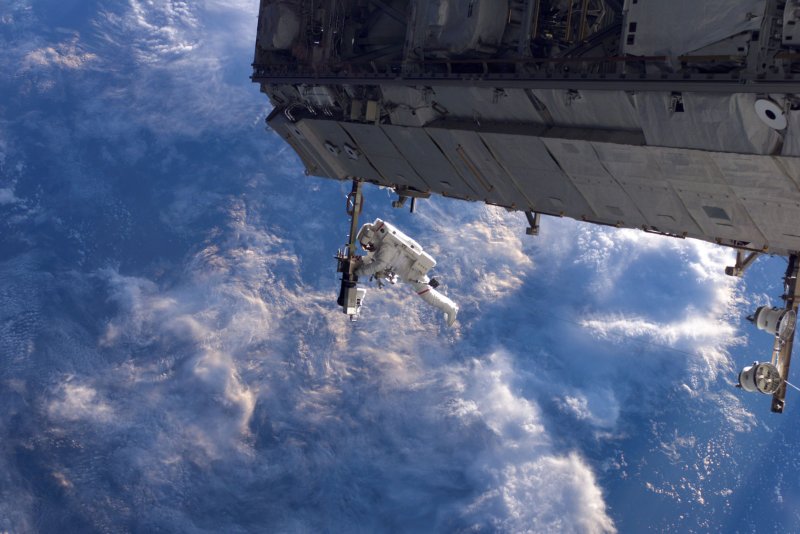NASA astronaut Robert Curbeam works on the International Space Station's S1 truss during the space shuttle Discovery's STS-116 mission in December 2006. File Photo by NASA/UPI |
License Photo
July 10 (UPI) -- Scientists have converted water into oxygen and hydrogen under microgravity conditions using only a semiconductor and sunlight. The technology could make long-distance space travel possible.
Researchers have previously developed a variety of water-splitting technologies for use on Earth. One of the simplest methods is called photocatalysis -- the technology uses photons, a semiconductor material and water to create electron-hole pairs.
When the material absorbs photons, a free electron is released. The reaction pulls a proton from the water, which can combine with the free electron to form hydrogen. The hole created by the released electron is replaced by an electron from water, which can combine with protons to form oxygen.
The system can produce hydrogen fuel for a spaceship and oxygen for astronauts to breathe.
To see if the technology can work under microgravity conditions, scientists dropped a photocatalysis system down a drop tower. When an object is in free fall, it experiences conditions similar to microgravity.
Photocatalysis results in bubble production near the catalyst material. On Earth, buoyancy causes the bubbles to float to the surface. But under microgravity conditions the bubbles remain near the catalyst.
Scientists were able to make nanoscale augmentations to the catalyst material's microstructure, creating tiny pyramid-like shapes on the surface. The texture causes bubbles to move to the tip of the pyramid and disengage.
Researchers detailed their design change this week in the journal Nature Communications.
The technology isn't yet perfect. Though scientists were able to get the bubbles to separate from the catalyst, they still remain in the water. The accumulating foam diminishes the efficiency of the hydrogen-production process.
"Engineering solutions around this problem will be key to successfully implementing technology in space -- with one possibility being using centrifugal forces from rotation of a spacecraft to separate the gases from the solution," researchers wrote in The Conversation.
There is also the problem of water supply. Though blasting off with large amounts of water is safer than carrying large amounts of fuel, water is heavy. Long-term space travel will require external sources. Eventually, scientists hope space-mining operations will be able to harvest water form asteroids.
"Thanks to this new study we are a step closer to long-duration human spaceflight," scientists said.















